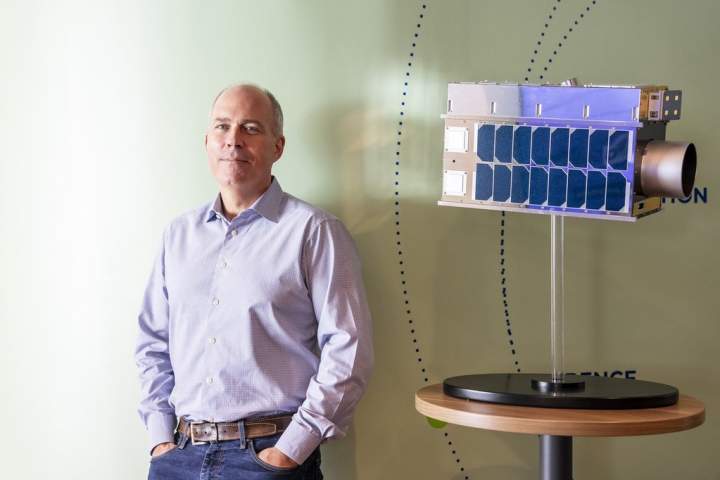Top Stories
Montreal Firm GHGSat Secures $47M to Combat Methane Emissions

UPDATE: In a groundbreaking move for climate action, Montreal-based GHGSat has just announced a major deal with ExxonMobil Corp. to monitor methane emissions at its facilities across Canada, the United States, and Asia. This comes alongside the company’s successful $47 million funding round aimed at accelerating its global expansion efforts in the fight against climate change.
Since its inception in 2016, GHGSat, led by CEO Stéphane Germain, has launched 14 satellites capable of detecting methane emissions from various industrial sources including oil and gas operations, coal mines, and landfills. With methane accounting for approximately one-third of global warming, the need for effective monitoring has never been more urgent.
Despite a perceived pullback from climate commitments in the U.S., Germain remains optimistic. He notes that companies are “playing the long game,” recognizing that their customers increasingly prioritize sustainability. “They understand that to compete in the future, they must be both cost-effective and minimize their carbon footprint,” Germain stated in a recent interview.
The urgency of methane monitoring is underscored by the U.S. administration’s recent actions to cut funding for vital carbon monitoring programs, including the Orbiting Carbon Observatories. However, this has not deterred GHGSat from expanding its client base, which now includes governments and major industrial emitters globally.
Germain highlighted how satellites measure gases in the atmosphere by analyzing light absorption, effectively providing a “spectral fingerprint” for methane. This technology is crucial for identifying emissions and mitigating potential safety risks, including gas leaks.
The company has already made strides in addressing environmental challenges, such as quantifying methane emissions from decaying organic matter in palm oil ponds across 12 countries. This proactive approach demonstrates GHGSat’s commitment to environmental accountability and innovation.
As the demand for satellite-based monitoring grows, experts like Dave Risk, a methane measurement scientist at St. Francis Xavier University, emphasize the global collaboration among satellites to measure emissions effectively. However, they also acknowledge challenges in regions with established regulations, where emissions are more difficult to detect.
Looking ahead, Germain envisions a world where every industrial facility is monitored daily for both carbon and methane emissions. He believes that consumer products will one day include carbon footprint labels, empowering buyers to make environmentally conscious decisions.
Canada has set ambitious goals, aiming to reduce oil and gas methane emissions by at least 75 percent from 2012 levels by 2030, as outlined in its 2022 methane strategy. While recent polls indicate a decline in the prioritization of climate issues among Canadians, Germain remains hopeful.
“To combat climate change effectively, we must not only focus on immediate concerns but also keep the long-term vision in mind,” he insisted.
As GHGSat continues to expand its role in resolving environmental crises, all eyes will be on the developments stemming from this pivotal partnership with ExxonMobil. The future of climate monitoring is unfolding now, and the stakes have never been higher.
-

 Politics4 weeks ago
Politics4 weeks agoSecwepemc First Nation Seeks Aboriginal Title Over Kamloops Area
-

 World5 months ago
World5 months agoScientists Unearth Ancient Antarctic Ice to Unlock Climate Secrets
-

 Entertainment5 months ago
Entertainment5 months agoTrump and McCormick to Announce $70 Billion Energy Investments
-

 Science5 months ago
Science5 months agoFour Astronauts Return to Earth After International Space Station Mission
-

 Lifestyle5 months ago
Lifestyle5 months agoTransLink Launches Food Truck Program to Boost Revenue in Vancouver
-

 Technology3 months ago
Technology3 months agoApple Notes Enhances Functionality with Markdown Support in macOS 26
-

 Lifestyle3 months ago
Lifestyle3 months agoManitoba’s Burger Champion Shines Again Amid Dining Innovations
-

 Top Stories2 months ago
Top Stories2 months agoUrgent Update: Fatal Crash on Highway 99 Claims Life of Pitt Meadows Man
-

 Politics4 months ago
Politics4 months agoUkrainian Tennis Star Elina Svitolina Faces Death Threats Online
-

 Sports5 months ago
Sports5 months agoSearch Underway for Missing Hunter Amid Hokkaido Bear Emergency
-

 Politics5 months ago
Politics5 months agoCarney Engages First Nations Leaders at Development Law Summit
-

 Technology5 months ago
Technology5 months agoFrosthaven Launches Early Access on July 31, 2025




















